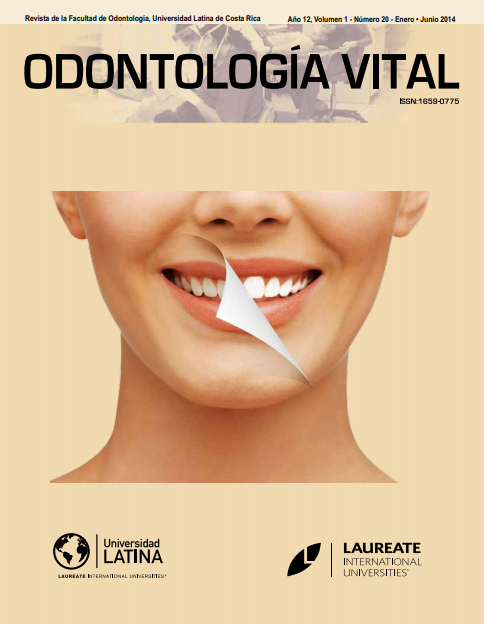Evaluación de mesiodens intraóseos mediante tomografía computadorizada de haz cónico
DOI:
https://doi.org/10.59334/ROV.v1i20.299Palabras clave:
Intraóseo, mesiodens, tomografía computadorizada de haz cónicoResumen
Introducción: Los dientes supernumerarios son aquellas piezas dentarias adicionales a su serie, un mayor porcentaje de ellos se encuentran intraóseos. Los mesiodens, ubicados en relación con la línea media maxilar generalmente, son los más comunes y pueden producir una serie de complicaciones. El objetivo de este estudio es evaluar las características de mesiodens intraóseos, y su relación con las estructuras anatómicas vecinas mediante la tomografía computadorizada de haz cónico.
Material y método: Se trata de un estudio de tipo no experimental, descriptivo, transversal y retrospectivo, con imágenes de tomografía computadorizada de haz cónico de 41 pacientes (44 casos) entre 8 y 38 años de edad, los que principalmente consultaron por tratamiento de ortodoncia en la Región Metropolitana de Santiago, Chile. Para la ejecución del trabajo de investigación, se evaluaron en dos oportunidades los archivos DICOM de la base de datos de un Centro Imagenológico Maxilofacial, y se determinó la concordancia intraobservador mediante el test de Kappa de Cohen.
Resultados: La morfología más frecuente correspondió a mesiodens cónicos. Un gran porcentaje de los mesiodens se encontraron invertidos, seguido de los ubicados horizontalmente. En más de la mitad de los casos se halló contacto de mesiodens con numerario, en alrededor de un 8% de los numerarios hubo reabsorción radicular por la presencia de mesiodens. En la mitad de los casos hubo algún tipo de contacto de los mesiodens con la cavidad nasal. Se encontró un importante porcentaje de contacto de corona y raíz de mesiodens con el conducto nasopalatino. En un quinto de los casos aproximadamente se localizó desalineación de numerarios adyacentes a mesiodens.
Conclusión: Se puede concluir que la tomografía computadorizada de haz cónico provee importante información sobre la posición de dientes supernumerarios, su espacio pericoronario, la relación con estructuras anatómicas vecinas y las posibles alteraciones que puede provocar su presencia.
Descargas
Referencias
Calvano Küchler E., Gomes Da Costa A., De Castro Costa M., Rezende Vieira A., Granjeiro J. M. (2010). Supernume-rary teeth vary depending on gender. Pediatric Dentistry ; 25(1):76-79. https://doi.org/10.1590/S1806-83242011000100013
Canut Brusola J. A. (2010). Ortodoncia Clínica y Terapéutica. 2nd ed. Barcelona: Masson; 2010: 397-399.
Cerda J, Villarroel L. (2010). Evaluación de la concordancia inter-observador en investigación pediátrica: Coefi-ciente de Kappa. Revista chilena de pediatría; 79(1):54-58. https://doi.org/10.4067/S0370-41062008000100008
De Vos W, Casselman J, Swennen G. R. J. (2009). Cone-beam computerized tomography (CBCT) imaging of the oral and maxillofacial region. A systematic review of the literature. Int. J. Oral Maxillofac. Surg; 38: 609-625. https://doi.org/10.1016/j.ijom.2009.02.028
Dev Kapil K., Suvil W., Fazil A., Singh Yajuvender H. (2012). Supernumerary Teeth. Indian Journal of Dental Scien-ces; 4(1):149-150.
Fleming PS, Xavier GM, Dibiase AT, Cobourne M. T. (2010). Revisiting the supernumerary: the epidemiological and molecular basis of extra teeth. British Dental Journal; 208(1):25-30. https://doi.org/10.1038/sj.bdj.2009.1177
Fuentes J, Villanueva R. (2011). Evaluación de caninos maxilares permanentes intraóseos en posición ectópica, por medio de tomografía computada de haz cónico. Tesis para optar al grado de Magíster en Odontología con especialización en Radiología Dental y Maxilofacial. Dic: 1-55.
Günduz K, Çelenk P, Zengin Z, Sümer P. (2008). Mesiodens: a radiographic study in children. J of Oral Science; 50(3):287-291. https://doi.org/10.2334/josnusd.50.287
Hyun HK et al. (2009). Clinical characteristics and complications associated with mesiodentes. J Oral Maxillofac Surg; 67(12):2639-2643. https://doi.org/10.1016/j.joms.2009.07.041
Katheria B, Kau C, Tate R, Chen J, English J, Bouquot J. (2010). Effectiveness of Impacted and Supernumerary Tooth Diagnosis from Traditional Radiography Versus Cone Beam Computed Tomography. Pediatric Dentistry Jul-Ago; 32:304-309.
Parolia A, Kundabala M, Dahal M, Mohan M, Tomas M. (2011). Management of supernumerary teeth. Journal of Conservative Dentistry Jul- Sept ; 14(3):221-224. https://doi.org/10.4103/0972-0707.85791
Proff P, Fanghänel J, Allegrini Jr. S, Bayerlein T, Gedrange T. (2006). Problems of supernumerary teeth, hyperdontia or dentes supernumerarii. Annals of Anatomy - Anatomischer Anzeiger Mar; 188(2):163-169. https://doi.org/10.1016/j.aanat.2005.10.005
Scarfe WC, Farman AG. (2008). What is Cone-Beam CT and how does it work? Dental Clinics of North America; 52(4):707-730. https://doi.org/10.1016/j.cden.2008.05.005
Shah A, Gill D, Tredwin C, Naini F. (2008). Diagnosis and Management of Supernumerary Teeth. Dental Update; 35(8):510-520. https://doi.org/10.12968/denu.2008.35.8.510
Van Buggenhout G, (2008). Mesiodens. European Journal of Medical Genetocs; 51(2):178-181. https://doi.org/10.1016/j.ejmg.2007.12.006
White SC, (2001). Radiología oral. Principios e interpretación. 4th ed.: Elsevier; 359.
Yoon RK, Chussid S, Davis MJ. (2008). Impacted maxillary anterior supernumerary teeth. N Y State Dent J; 74(6):24-27.
Yoon RK, Chussid S, Davis MJ. (2011). Mesiodens: A clinical and radiographic study in children. Journal of Indian Society of Periodontics and Preventive Dentistry; 29(11):34-38. https://doi.org/10.4103/0970-4388.79928
Descargas
Publicado
Número
Sección
Licencia
Derechos de autor 2014 Rodrigo Villanueva Conejeros, Tania Pérez Oñate

Esta obra está bajo una licencia internacional Creative Commons Atribución 4.0.
Los autores que publican con Odontologia Vital aceptan los siguientes términos:
- Los autores conservan los derechos de autor sobre la obra y otorgan a la Universidad Latina de Costa Rica el derecho a la primera publicación, con la obra reigstrada bajo la licencia Creative Commons de Atribución/Reconocimiento 4.0 Internacional, que permite a terceros utilizar lo publicado siempre que mencionen la autoría del trabajo y a la primera publicación en esta revista.
- Los autores pueden llegar a acuerdos contractuales adicionales por separado para la distribución no exclusiva de la versión publicada del trabajo de Odontología Vital (por ejemplo, publicarlo en un repositorio institucional o publicarlo en un libro), con un reconocimiento de su publicación inicial en Odontología Vital.
- Se permite y recomienda a los autores/as a compartir su trabajo en línea (por ejemplo: en repositorios institucionales o páginas web personales) antes y durante el proceso de envío del manuscrito, ya que puede conducir a intercambios productivos, a una mayor y más rápida citación del trabajo publicado.








